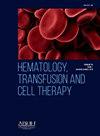A CASE OF MARGINAL ZONE LYMPHOMA PRESENTING WITH DIPLOPIA
IF 1.8
Q3 HEMATOLOGY
引用次数: 0
Abstract
Objective
Marginal zone lymphoma (MZL) is characterized by the proliferation of B cells in post-germinal centers located in mucosa-associated lymphoid tissue (MALT), lymph nodes, and the spleen. MZL typically presents with an indolent clinical course. The average age at diagnosis is 60, with a slight female predominance, and it accounts for 5-17% of non-Hodgkin lymphomas (NHL). MZL is categorized into three subtypes based on the site of involvement: extranodal, splenic, and nodal MZL. Although these subtypes share many morphological and immunophenotypic characteristics as well as a slow clinical course, they can differ in terms of frequency, pathogenesis, clinical presentation, and treatment approach. The most common subtype is extranodal MZL, while nodal MZL is the least common.
Case Report
A 51-year-old female patient presented to the clinic with a complaint of diplopia that had lasted for the past week. Physical examination revealed limited lateral gaze and anisocoria in the right eye, with other systemic examinations were normal. There were no B symptoms. Complete blood count, biochemical tests, serum electrolytes, and coagulation tests were within normal limits.
Contrast-enhanced orbital MRI showed a lesion in the right intraorbital intraconal area, adjacent to the lateral aspect of the optic nerve and the medial aspect of the lateral rectus muscle. The lesion extended from the retroocular area to the orbital apex, obliterating intraorbital fat planes. It measured 35 × 13 mm in the axial plane, was hypointense on T2-weighted imaging and T1-weighted imaging, and showed homogeneous diffusion restriction on diffusion-weighted imaging. Post-contrast series revealed intense homogeneous enhancement of the soft tissue. The lesion measured 27 × 17 mm in the coronal plane. The findings were primarily suggestive of lymphoma involvement.
PET-CT scan identified a hypermetabolic soft tissue lesion in the right intraorbital-retrobulbar area, continuous from the lateral aspect of the lateral rectus muscle to the lateral orbit, consistent with lymphoma. No extraocular nodal or visceral hypermetabolic foci were detected.
Orbital biopsy results confirmed marginal zone lymphoma. Although radiotherapy could have been considered as a treatment option for localized involvement, the decision was made to administer 6 cycles of RB (Rituximab and Bendamustine) chemotherapy to the patient in order to avoid complications associated with radiotherapy due to the lesion's location in the orbital region. Follow-up PET-CT after 6 cycles of RB showed complete metabolic response with total regression of the hypermetabolic soft tissue lesion in the right retroocular area. The patient is currently in remission.
This case is discussed due to the rare occurrence of ocular involvement in marginal zone lymphoma.
求助全文
约1分钟内获得全文
求助全文
来源期刊

Hematology, Transfusion and Cell Therapy
Multiple-
CiteScore
2.40
自引率
4.80%
发文量
1419
审稿时长
30 weeks
 求助内容:
求助内容: 应助结果提醒方式:
应助结果提醒方式:


